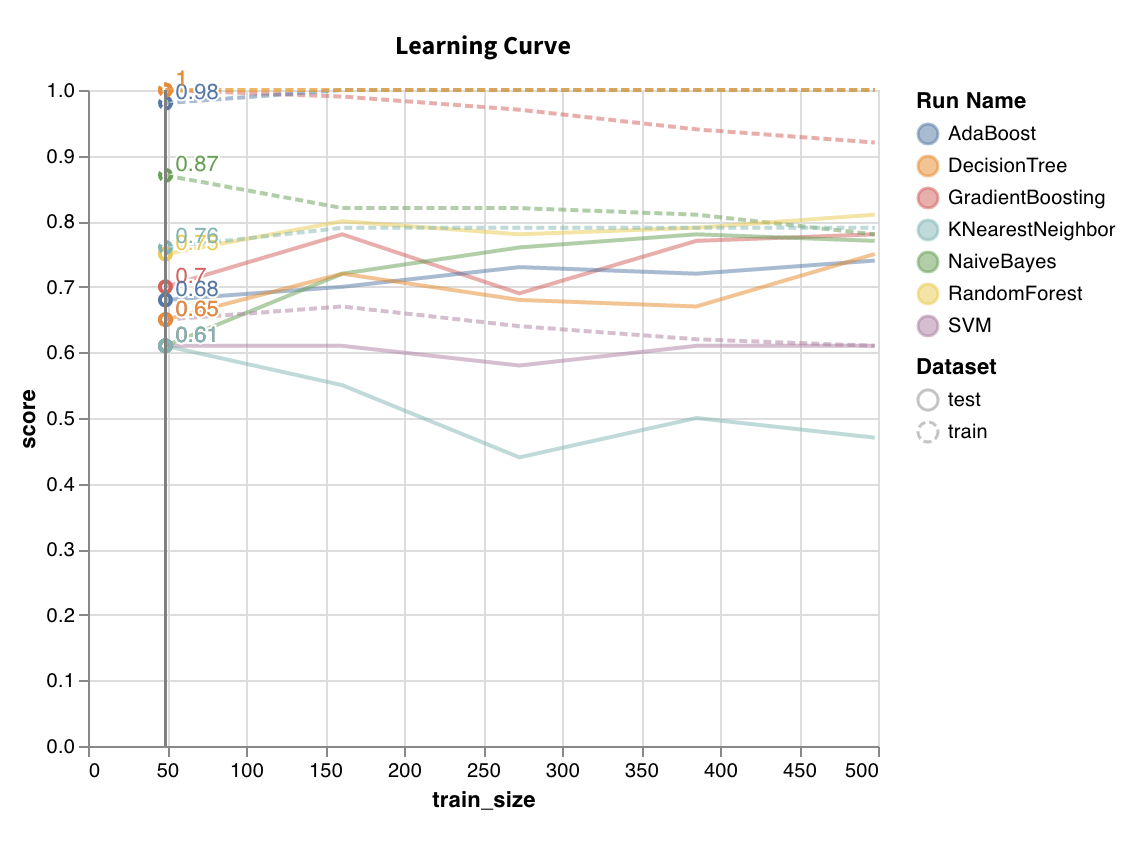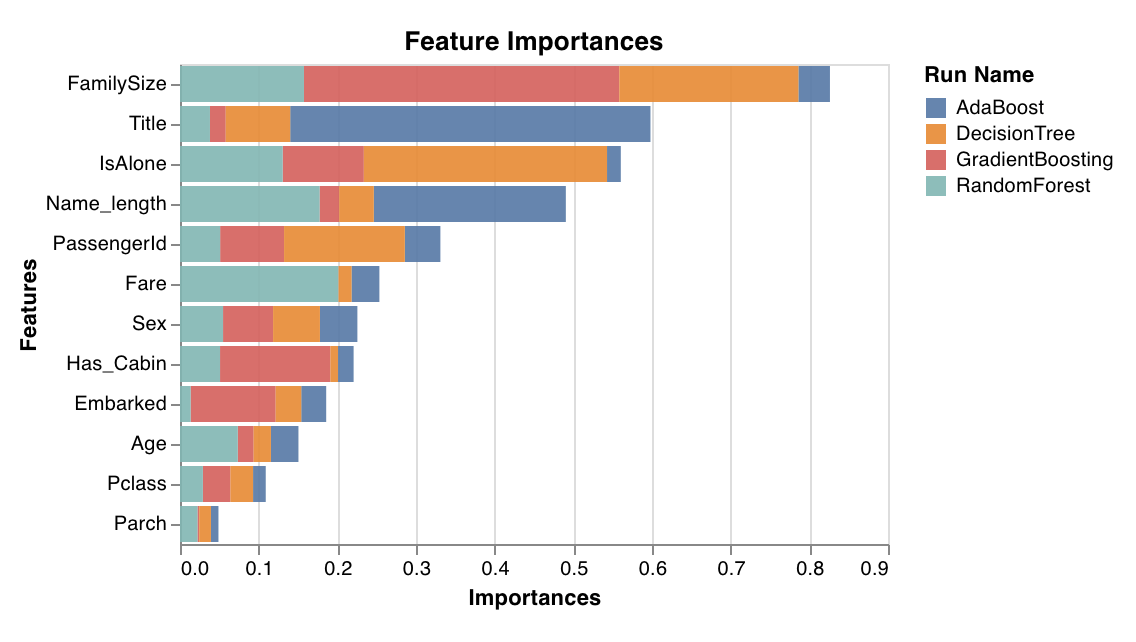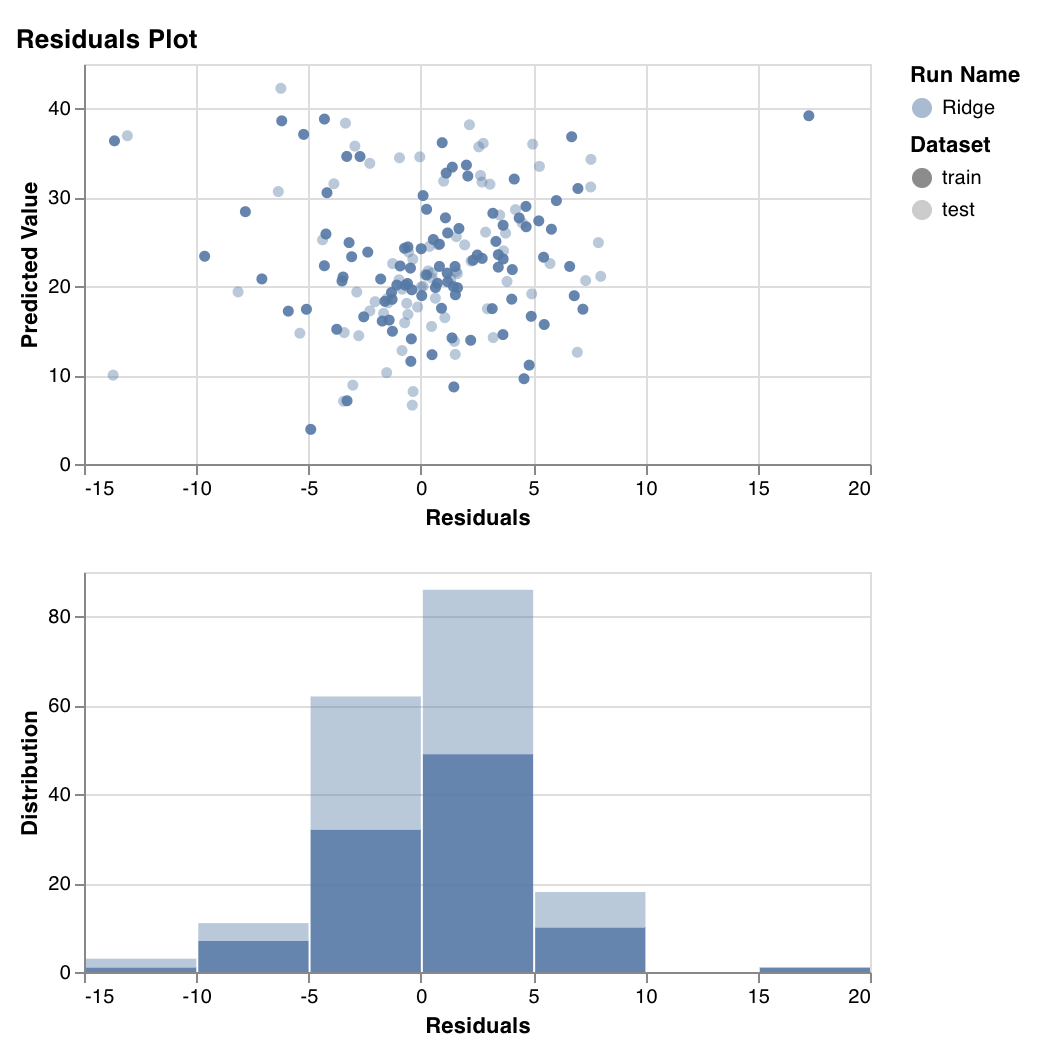Scikit-Learn
You can use wandb to visualize and compare your scikit-learn models' performance with just a few lines of code. Try an example →
🔥 Getting Started
Sign up and Log in to wandb
a) Sign up for a free account
b) Pip install the wandb library
c) To log in in your training script, you'll need to be signed in to you account at www.wandb.ai, then you will find your API key on the Authorize page.
If you are using Weights and Biases for the first time you might want to check out our quickstart
- Command Line
- Notebook
pip install wandb
wandb login
!pip install wandb
wandb.login()
Logging Metrics
import wandb
wandb.init(project="visualize-sklearn")
y_pred = clf.predict(X_test)
accuracy = sklearn.metrics.accuracy_score(y_true, y_pred)
# If logging metrics over time, then use wandb.log
wandb.log({"accuracy": accuracy})
# OR to log a final metric at the end of training you can also use wandb.summary
wandb.summary["accuracy"] = accuracy
Making Plots
Step 1: Import wandb and initialize a new run.
import wandb
wandb.init(project="visualize-sklearn")
Step 2: Visualize individual plots
After training a model and making predictions you can then generate plots in wandb to analyze your predictions. See the Supported Plots section below for a full list of supported charts
# Visualize single plot
wandb.sklearn.plot_confusion_matrix(y_true, y_pred, labels)
Or visualize all plots at once
W&B has functions such as plot_classifier that will plot several relevant plots:
# Visualize all classifier plots
wandb.sklearn.plot_classifier(
clf,
X_train,
X_test,
y_train,
y_test,
y_pred,
y_probas,
labels,
model_name="SVC",
feature_names=None,
)
# All regression plots
wandb.sklearn.plot_regressor(reg, X_train, X_test, y_train, y_test, model_name="Ridge")
# All clustering plots
wandb.sklearn.plot_clusterer(
kmeans, X_train, cluster_labels, labels=None, model_name="KMeans"
)
Or plot existing matplotlib plots:
Plots created on Matplotlib can also be logged on W&B dashboard. To do that, it is first required to install plotly.
pip install plotly
Finally, the plots can be logged on W&B's dashboard as follows:
import matplotlib.pyplot as plt
import wandb
wandb.init(project="visualize-sklearn")
# do all the plt.plot(), plt.scatter(), etc. here.
# ...
# instead of doing plt.show() do:
wandb.log({"plot": plt})
Supported Plots
Learning Curve

Trains model on datasets of varying lengths and generates a plot of cross validated scores vs dataset size, for both training and test sets.
wandb.sklearn.plot_learning_curve(model, X, y)
- model (clf or reg): Takes in a fitted regressor or classifier.
- X (arr): Dataset features.
- y (arr): Dataset labels.
ROC

ROC curves plot true positive rate (y-axis) vs false positive rate (x-axis). The ideal score is a TPR = 1 and FPR = 0, which is the point on the top left. Typically we calculate the area under the ROC curve (AUC-ROC), and the greater the AUC-ROC the better.
wandb.sklearn.plot_roc(y_true, y_probas, labels)
- y_true (arr): Test set labels.
- y_probas (arr): Test set predicted probabilities.
- labels (list): Named labels for target variable (y).
Class Proportions

Plots the distribution of target classes in training and test sets. Useful for detecting imbalanced classes and ensuring that one class doesn't have a disproportionate influence on the model.
wandb.sklearn.plot_class_proportions(y_train, y_test, ['dog', 'cat', 'owl'])
- y_train (arr): Training set labels.
- y_test (arr): Test set labels.
- labels (list): Named labels for target variable (y).
Precision Recall Curve

Computes the tradeoff between precision and recall for different thresholds. A high area under the curve represents both high recall and high precision, where high precision relates to a low false positive rate, and high recall relates to a low false negative rate.
High scores for both show that the classifier is returning accurate results (high precision), as well as returning a majority of all positive results (high recall). PR curve is useful when the classes are very imbalanced.
wandb.sklearn.plot_precision_recall(y_true, y_probas, labels)
- y_true (arr): Test set labels.
- y_probas (arr): Test set predicted probabilities.
- labels (list): Named labels for target variable (y).
Feature Importances

Evaluates and plots the importance of each feature for the classification task. Only works with classifiers that have a feature_importances_ attribute, like trees.
wandb.sklearn.plot_feature_importances(model, ['width', 'height, 'length'])
- model (clf): Takes in a fitted classifier.
- feature_names (list): Names for features. Makes plots easier to read by replacing feature indexes with corresponding names.
Calibration Curve

Plots how well calibrated the predicted probabilities of a classifier are and how to calibrate an uncalibrated classifier. Compares estimated predicted probabilities by a baseline logistic regression model, the model passed as an argument, and by both its isotonic calibration and sigmoid calibrations.
The closer the calibration curves are to a diagonal the better. A transposed sigmoid like curve represents an overfitted classifier, while a sigmoid like curve represents an underfitted classifier. By training isotonic and sigmoid calibrations of the model and comparing their curves we can figure out whether the model is over or underfitting and if so which calibration (sigmoid or isotonic) might help fix this.
For more details, check out sklearn's docs.
wandb.sklearn.plot_calibration_curve(clf, X, y, 'RandomForestClassifier')
- model (clf): Takes in a fitted classifier.
- X (arr): Training set features.
- y (arr): Training set labels.
- model_name (str): Model name. Defaults to 'Classifier'
Confusion Matrix

Computes the confusion matrix to evaluate the accuracy of a classification. It's useful for assessing the quality of model predictions and finding patterns in the predictions the model gets wrong. The diagonal represents the predictions the model got right, i.e. where the actual label is equal to the predicted label.
wandb.sklearn.plot_confusion_matrix(y_true, y_pred, labels)
- y_true (arr): Test set labels.
- y_pred (arr): Test set predicted labels.
- labels (list): Named labels for target variable (y).
Summary Metrics

Calculates summary metrics (like f1, accuracy, precision and recall for classification and mse, mae, r2 score for regression) for both regression and classification algorithms.
wandb.sklearn.plot_summary_metrics(model, X_train, y_train, X_test, y_test)
- model (clf or reg): Takes in a fitted regressor or classifier.
- X (arr): Training set features.
- y (arr): Training set labels.
- X_test (arr): Test set features.
- y_test (arr): Test set labels.
Elbow Plot

Measures and plots the percentage of variance explained as a function of the number of clusters, along with training times. Useful in picking the optimal number of clusters.
wandb.sklearn.plot_elbow_curve(model, X_train)
- model (clusterer): Takes in a fitted clusterer.
- X (arr): Training set features.
Silhouette Plot

Measures & plots how close each point in one cluster is to points in the neighboring clusters. The thickness of the clusters corresponds to the cluster size. The vertical line represents the average silhouette score of all the points.
Silhouette coefficients near +1 indicate that the sample is far away from the neighboring clusters. A value of 0 indicates that the sample is on or very close to the decision boundary between two neighboring clusters and negative values indicate that those samples might have been assigned to the wrong cluster.
In general we want all silhouette cluster scores to be above average (past the red line) and as close to 1 as possible. We also prefer cluster sizes that reflect the underlying patterns in the data.
wandb.sklearn.plot_silhouette(model, X_train, ['spam', 'not spam'])
- model (clusterer): Takes in a fitted clusterer.
- X (arr): Training set features.
- cluster_labels (list): Names for cluster labels. Makes plots easier to read by replacing cluster indexes with corresponding names.
Outlier Candidates Plot

Measures a datapoint's influence on regression model via cook's distance. Instances with heavily skewed influences could potentially be outliers. Useful for outlier detection.
wandb.sklearn.plot_outlier_candidates(model, X, y)
- model (regressor): Takes in a fitted classifier.
- X (arr): Training set features.
- y (arr): Training set labels.
Residuals Plot

Measures and plots the predicted target values (y-axis) vs the difference between actual and predicted target values (x-axis), as well as the distribution of the residual error.
Generally, the residuals of a well-fit model should be randomly distributed because good models will account for most phenomena in a data set, except for random error.
wandb.sklearn.plot_residuals(model, X, y)
model (regressor): Takes in a fitted classifier.
X (arr): Training set features.
y (arr): Training set labels.
If you have any questions, we'd love to answer them in our slack community.
Example
- Run in colab: A simple notebook to get you started